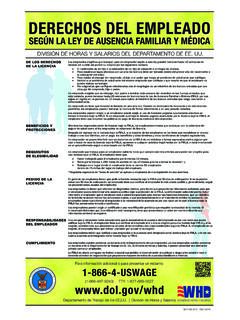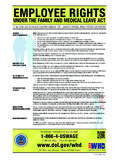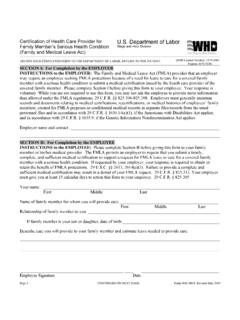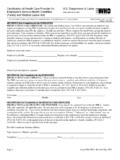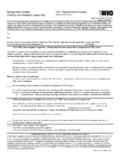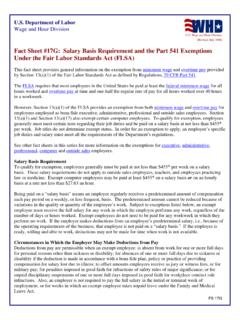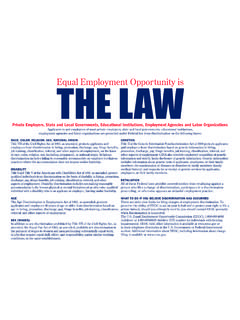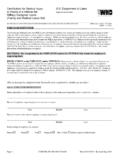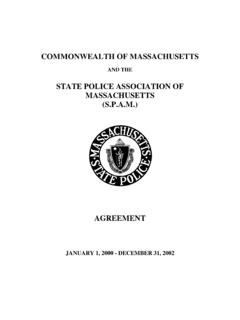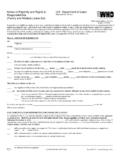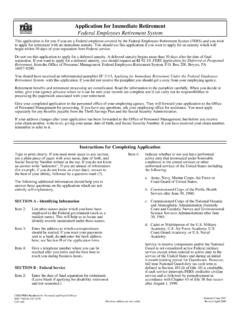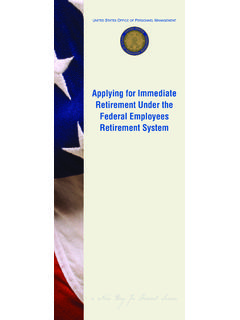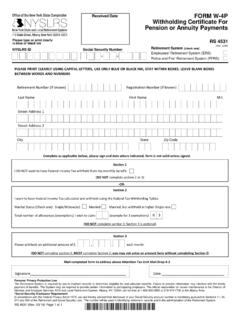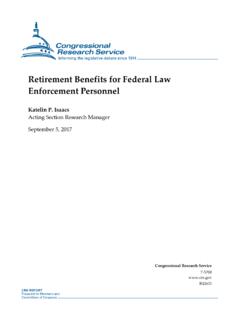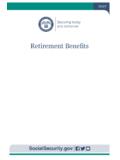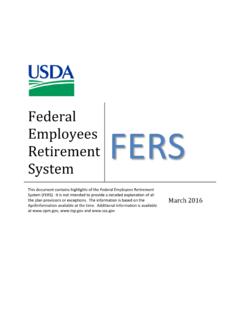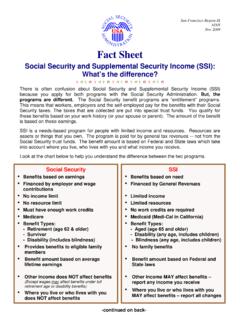Transcription of FAQs about Retirement Plans and ERISA - DOL
1 FAQs about Retirement Plans and ERISA Department of Labor Employee Benefits Security Administration What is ERISA ? The Employee Retirement Income Security Act of 1974, or ERISA , protects the assets of millions of Americans so that funds placed in Retirement Plans during their working lives will be there when they retire. ERISA is a federal law that sets minimum standards for Retirement Plans in private industry. For example, if your employer maintains a Retirement plan, ERISA specifies when you must be allowed to become a participant, how long you have to work before you have a non-forfeitable interest in your benefit, how long you can be away from your job before it might affect your benefit, and whether your spouse has a right to part of your benefit in the event of your death. Most of the provisions of ERISA are effective for plan years beginning on or after January 1, 1975.
2 ERISA does not require any employer to establish a Retirement plan. It only requires that those who establish Plans must meet certain minimum standards. The law generally does not specify how much money a participant must be paid as a benefit. ERISA does the following: Requires Plans to provide participants with information about the plan including importantinformation about plan features and funding. The plan must furnish some information regularlyand automatically. Some is available free of charge, some is not. Sets minimum standards for participation, vesting, benefit accrual and funding. The law defineshow long a person may be required to work before becoming eligible to participate in a plan, toaccumulate benefits, and to have a non-forfeitable right to those benefits. The law alsoestablishes detailed funding rules that require plan sponsors to provide adequate funding for yourplan.
3 Requires accountability of plan fiduciaries. ERISA generally defines a fiduciary as anyone whoexercises discretionary authority or control over a plan's management or assets, including anyonewho provides investment advice to the plan. Fiduciaries who do not follow the principles ofconduct may be held responsible for restoring losses to the plan. Gives participants the right to sue for benefits and breaches of fiduciary duty. Guarantees payment of certain benefits if a defined plan is terminated, through a federallychartered corporation, known as the Pension Benefit Guaranty is a defined benefit plan? A defined benefit plan, funded by the employer, promises you a specific monthly benefit at Retirement . The plan may state this promised benefit as an exact dollar amount, such as $100 per month at Retirement . Or, more often, it may calculate your benefit through a formula that includes factors such as your salary, your age, and the number of years you worked at the company.
4 For example, your pension benefit might be equal to 1 percent of your average salary for the last 5 years of employment times your total years of service. 2 What is a defined contribution plan? A defined contribution plan, on the other hand, does not promise you a specific benefit amount at Retirement . Instead, you and/or your employer contribute money to your individual account in the plan. In many cases, you are responsible for choosing how these contributions are invested, and deciding how much to contribute from your paycheck through pretax deductions. Your employer may add to your account, in some cases by matching a certain percentage of your contributions. The value of your account depends on how much is contributed and how well the investments perform. At Retirement , you receive the balance in your account, reflecting the contributions, investment gains or losses, and any fees charged against your account.
5 The 401(k) plan is a popular type of defined contribution plan. There are four types of 401(k) Plans : traditional 401(k), safe harbor 401(k), SIMPLE 401(k), and automatic enrollment 401(k) Plans . The SIMPLE IRA plan, SEP, employee stock ownership plan (ESOP), and profit sharing plan are other examples of defined contribution Plans . What are simplified employee Retirement Plans (SEPs)? Simplified Employee Pension Plan (SEP) A plan in which the employer makes contributions on a tax-favored basis to individual Retirement accounts (IRAs) owned by the employees. If certain conditions are met, the employer is not subject to the reporting and disclosure requirements of most Retirement Plans . Under a SEP, an IRA is set up by or for an employee to accept the employer's contributions. What are 401(k) Plans ? 401(k) Plan In this type of defined contribution plan, the employee can make contributions from his or her paycheck before taxes are taken out.
6 The contributions go into a 401(k) account, with the employee often choosing the investments based on options provided under the plan. In some Plans , the employer also makes contributions, matching the employee's contributions up to a certain percentage. SIMPLE and safe harbor 401(k) Plans have additional employer contribution and vesting requirements. What are profit sharing Plans or stock bonus Plans ? Profit Sharing Plan A profit sharing plan allows the employer each year to determine how much to contribute to the plan (out of profits or otherwise) in cash or employer stock. The plan contains a formula for allocating the annual contribution among the participants. What are employee stock ownership Plans (ESOPs)? Employee Stock Ownership Plan (ESOP) A type of defined contribution plan that is invested primarily in employer stock.
7 Who can participate in your employer's Retirement plan? Once you have learned what type of Retirement plan your employer offers, you need to find out when you can participate in the plan and begin to earn benefits. Plan rules can vary as long as they meet the requirements under federal law. You need to check with your plan or review the plan booklet (called the Summary Plan Description) to learn your plan's rules and requirements. Your plan may require you to work for the company for a period of time before you may participate in the plan. In addition, there typically is a time frame for when you begin to accumulate benefits and earn the right to them (sometimes referred to as "vesting"). 3 Find out if you are within the group of employees covered by your employer's Retirement plan. federal law allows employers to include certain groups of employees and exclude others from a Retirement plan.
8 For example, your employer may sponsor one plan for salaried employees and another for union employees. Part-time employees may be eligible if they work at least 1,000 hours per year, which is about 20 hours per week. So if you work part-time, find out if you are covered. When can your participation begin? Once you know you are covered, you need to find out when you can begin to participate in the plan. You can find this information in your plan's Summary Plan Description. federal law sets minimum requirements, but a plan may be more generous. Generally, a plan may require an employee to be at least 21 years old and to have a year of service with the company before the employee can participate in a plan. However, Plans may allow employees to begin participation before reaching age 21 or completing one year of service.
9 For administrative reasons, your participation may be delayed up to 6 months after you meet these age and service criteria, or until the start of the next plan year, whichever is sooner. The plan year is the calendar year, or an alternative 12-month period, that a Retirement plan uses for plan administration. Because the rules can vary, it is important that you learn the rules for your plan. Employers have some flexibility to require additional years of service in some circumstances. For example, if your plan allows you to vest (discussed in detail later) immediately upon participating in the plan, it may require that you work for the company for two years before you may participate in the plan. federal law also imposes other participation rules for certain circumstances. For example, if you were an older worker when you were hired, you cannot be excluded from participating in the plan just because you are close to Retirement age.
10 Some 401(k) and SIMPLE IRA Plans enroll employees automatically. This means that you will automatically become a participant in the plan unless you choose to opt out. The plan will deduct a set contribution level from your paycheck and put it into a predetermined investment. If your employer has an automatic enrollment plan, you should receive a notice describing the automatic contribution process, when your participation begins, your opportunity to opt out of the plan or change your contribution level, and where your automatic contributions are invested. If you are in a 401(k), the notice will also describe your right to change investments, or if you are in a SIMPLE IRA plan, your right to change the financial institution where your contributions are invested. When do you begin to accumulate benefits? Once you begin to participate in a Retirement plan, you need to understand how you accrue or earn benefits.
